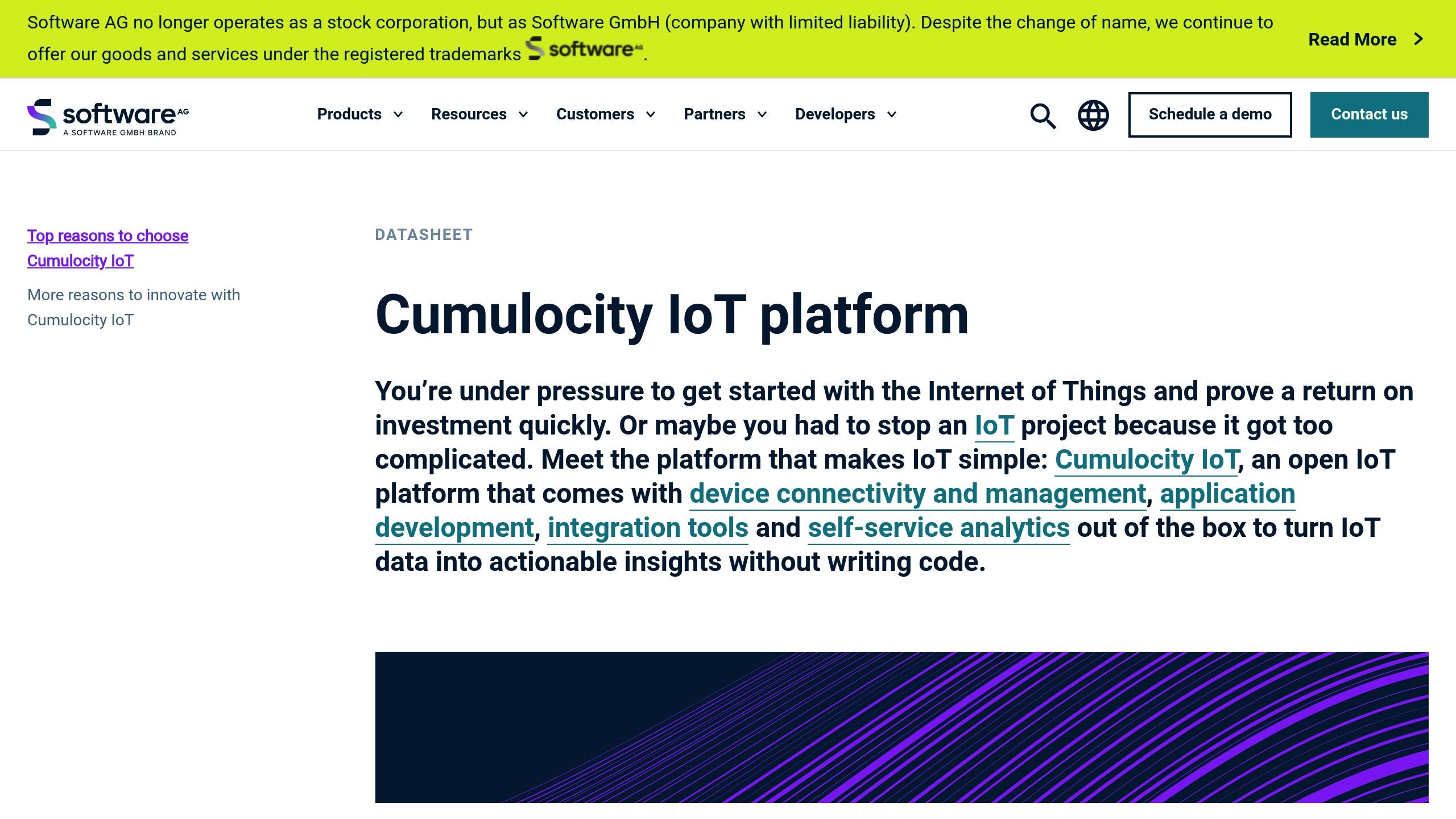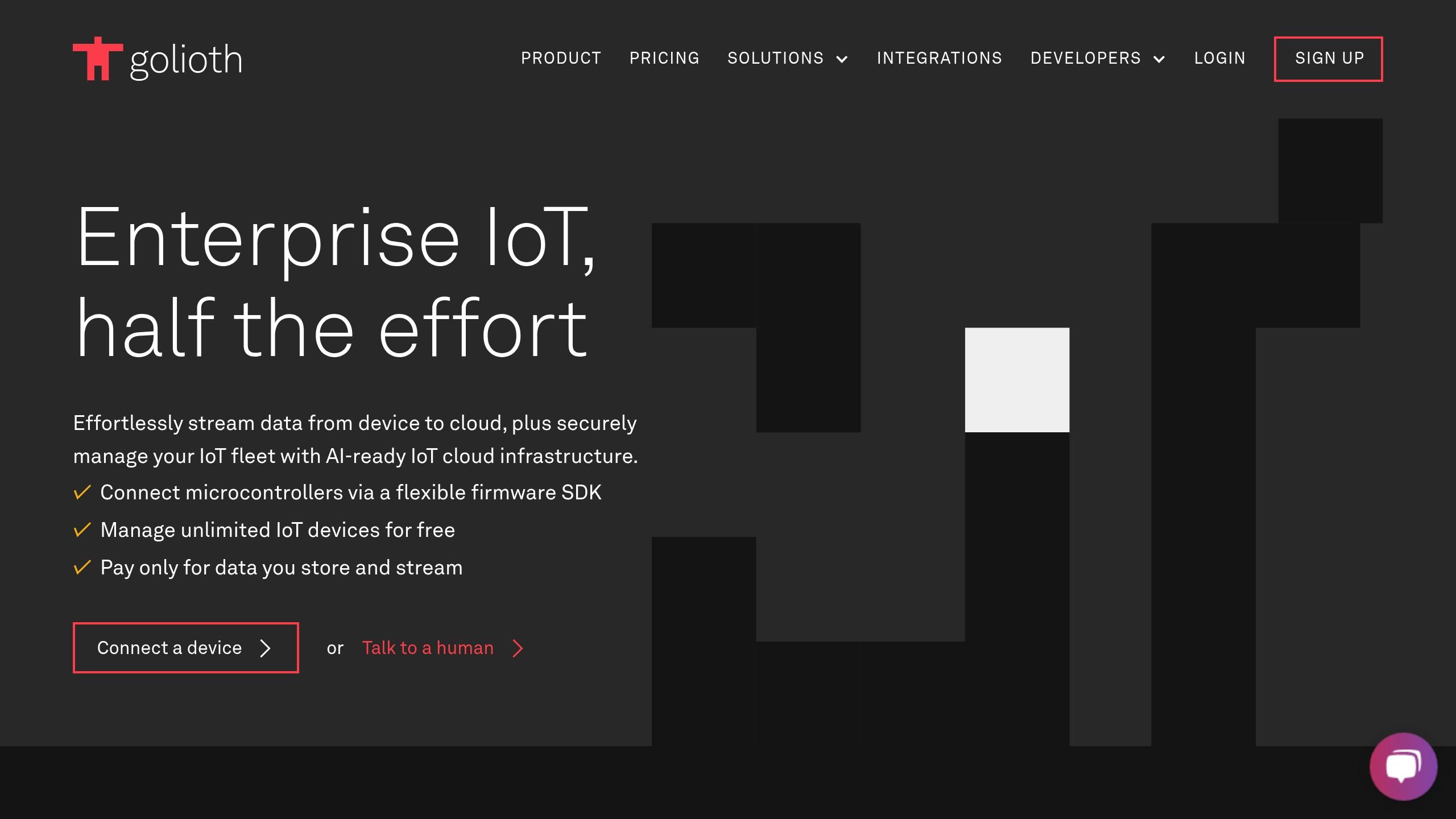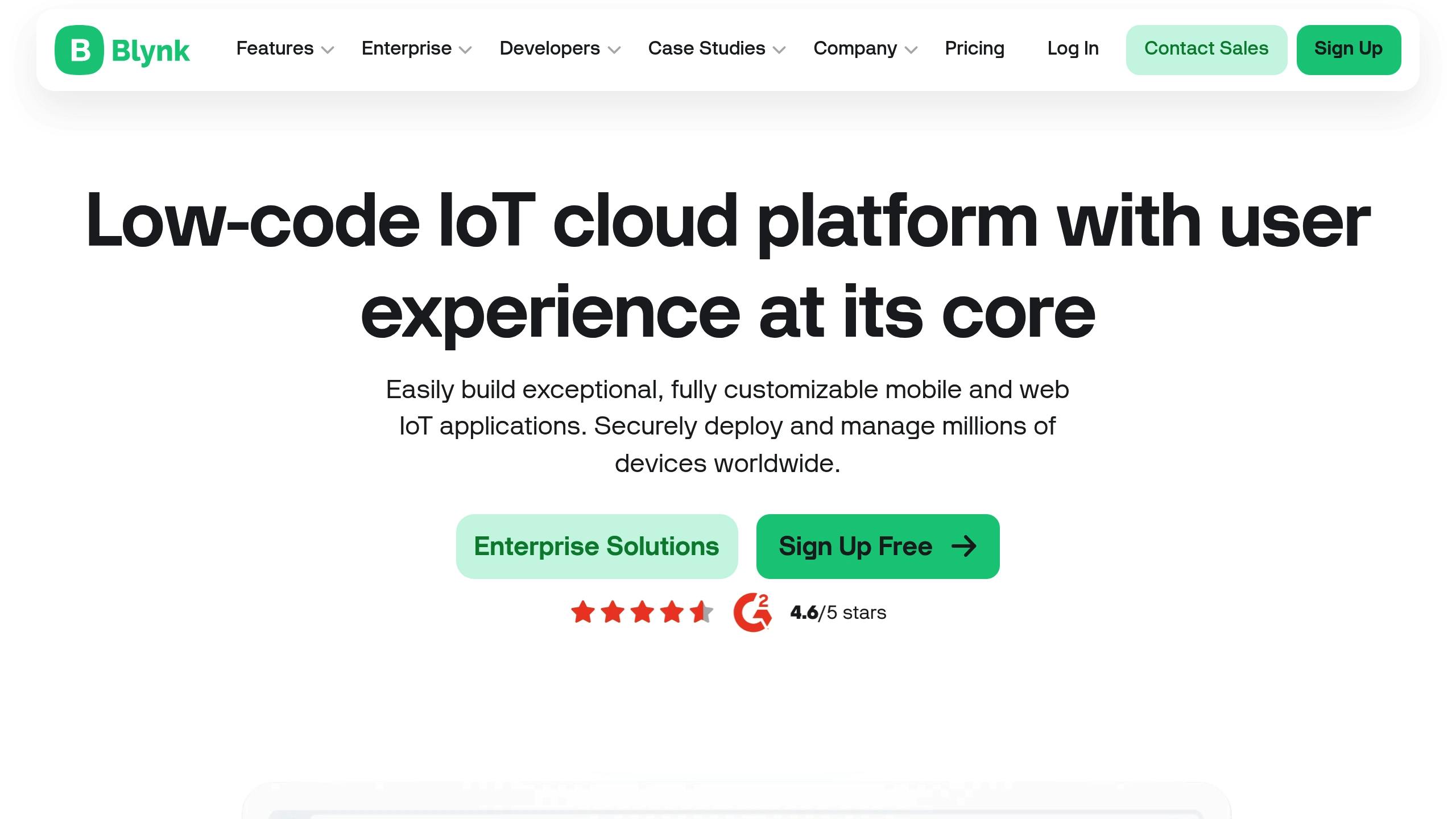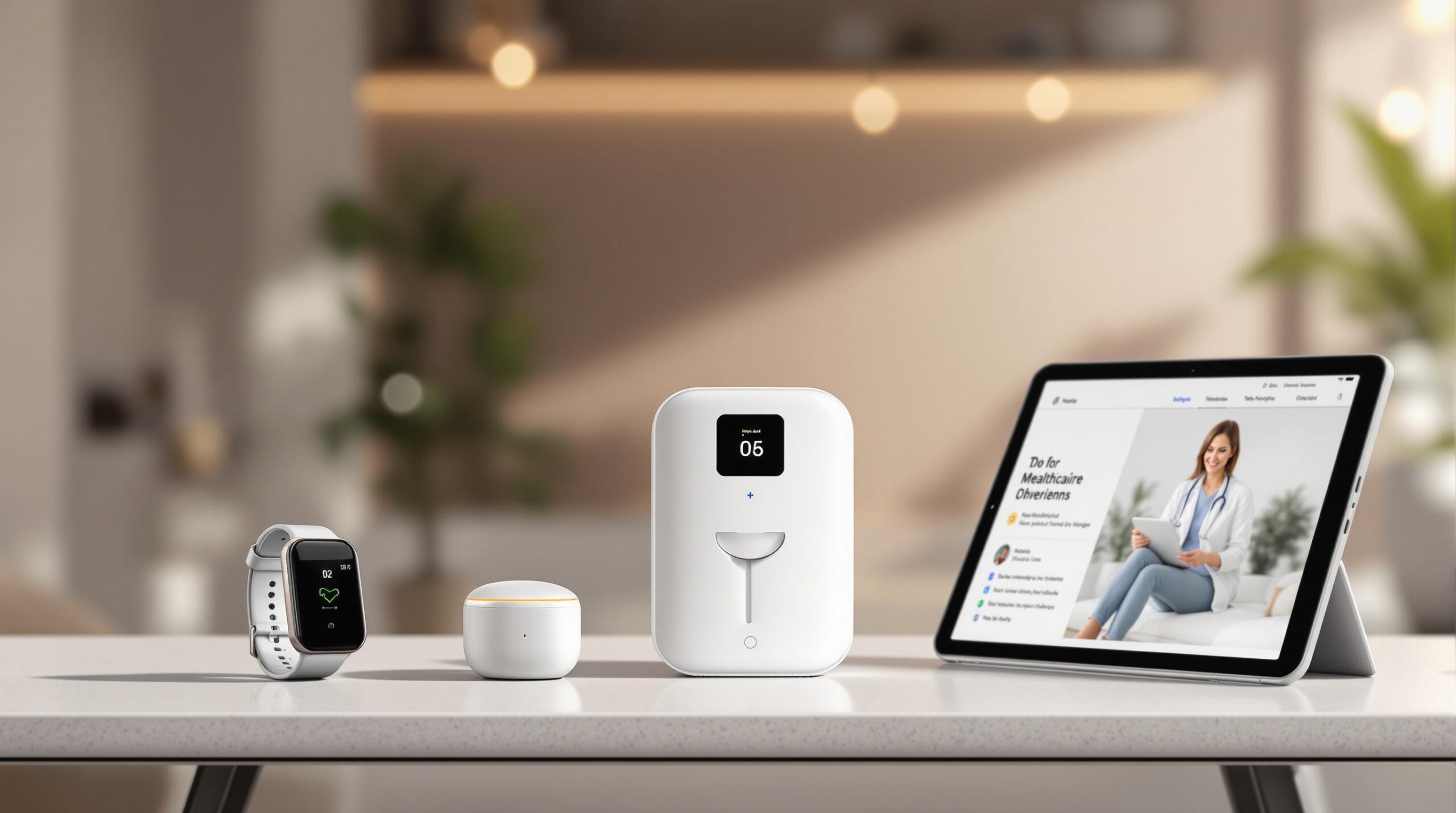
Looking for the best IoT platforms to develop healthcare apps? Here are three top contenders:
- Golioth: Flexible and device-agnostic with strong data management tools.
- Cumulocity: Enterprise-ready with fast deployment and high security.
- Blynk: User-friendly and cost-effective for smaller teams and quick projects.
These platforms are transforming healthcare by enabling remote monitoring, better data management, and faster development. Whether you’re building for large enterprises or small teams, there’s an option for you.
Quick Comparison:
| Feature | Golioth | Cumulocity | Blynk |
|---|---|---|---|
| Hardware Support | 100+ boards | 170+ pre-integrated devices | 400+ hardware models |
| Ease of Use | Flexible SDK | Zero-code tools | Drag-and-drop interface |
| Security | Secure Firmware SDK | Multi-tenant architecture | Encryption & user auth |
| Best For | Custom hardware projects | Enterprise-level solutions | Consumer-focused apps |
Each platform has unique strengths, so choose based on your project’s scale, technical needs, and budget.
Getting started with Cumulocity IoT: Device Management Overview
1. Golioth
Golioth provides IoT connectivity that works across a variety of devices, sensors, and hardware without tying users to a specific vendor. Its secure Firmware SDK simplifies device management, making it easier to develop custom IoT solutions for healthcare. The pipelines.yaml file streamlines data streaming and transformation, which is especially useful for healthcare IoT applications.
| Feature | Capability | Benefit |
|---|---|---|
| Connectivity Support | Cellular, WiFi, Ethernet, Mesh | Multiple deployment options |
| Operating System Compatibility | Zephyr, Nordic nRF Connect SDK, ESP-IDF, FreeRTOS | Wide hardware compatibility |
| Device Management | OTA updates, Remote procedure calls, Device settings | Easier maintenance |
| Data Management | LightDB state storage, Custom routing | Better data control |
Golioth’s performance ratings highlight its effectiveness: G2 score: 4.4/5, support: 9.0/10, and ease of use: 8.4/10 .
"Golioth is device, connectivity, and service agnostic. We act as a universal connector enabling you to connect sensors quickly, capture data instantly, and easily pipe it anywhere you want." – Golioth
The platform also integrates AI for managing, deploying, and training models using live data. Its LightDB state feature supports digital twins, ensuring data consistency even if connectivity is interrupted .
However, Golioth does have some limitations. The free tier is limited to one project and single-user access . Additional costs apply for specific features:
- OTA update bandwidth: $0.35/MB
- Logging storage: $0.20/MB
- Data streaming to LightDB: $1/GB
- Routing data to third-party services: $0.40/MB
These fees can add up quickly, especially for healthcare applications that process large amounts of data.
2. Cumulocity
Cumulocity provides a secure and scalable IoT platform with a standardized data model, making it easier to unify medical data across various devices.
| Feature | Capability | Healthcare Benefit |
|---|---|---|
| Device Integration | Over 170 pre-integrated devices, MQTT/HTTP REST support | Quick setup for medical IoT devices |
| Security Features | Multi-tenancy, Single Sign-On (SSO) | Ensures HIPAA-compliant data protection |
| Deployment Options | Cloud, on-premises, edge, hybrid | Flexible infrastructure to suit all needs |
| Analytics | Real-time streaming, smart rules | Enables instant patient data analysis |
This platform combines a developer-friendly interface with enterprise-grade security. Given the 400% increase in IoT malware attacks during the first half of 2023 , Cumulocity’s security-first approach – established in 2010 – stands out as a critical safeguard for sensitive healthcare data.
In March 2023, QTRS adopted Cumulocity for real-time patient monitoring. Daniel Oxley-Boyd, QTRS’s Managing Director, shared:
"We achieved a lot more than I ever expected and we are continually developing as we discover more about what Cumulocity has to offer."
That said, its standardized processes may limit the ability to create highly customized solutions for specific needs.
For healthcare applications, key security measures include:
- Protecting physical devices from tampering.
- Using role-based access control to secure applications and data.
- Strengthening network security, particularly at edge locations.
Cumulocity’s Digital Twin Manager (DTM) ensures consistent data representation across different medical devices. Paired with the Cockpit application, it simplifies the monitoring of critical healthcare metrics and improves alarm management.
Next, we’ll explore another platform that takes a different approach to IoT integration.
sbb-itb-7af2948
3. Blynk
Blynk is a low-code IoT platform that handles over 180 billion hardware requests each month across 136 countries . It focuses on simplifying IoT integration, making it an effective choice for healthcare and research applications.
While Golioth offers vendor-agnostic connectivity and Cumulocity targets enterprise-level scalability, Blynk stands out for its ability to deliver quick and cost-efficient solutions, particularly for healthcare needs.
| Feature | Capability | Benefits |
|---|---|---|
| Device Support | WiFi, Ethernet, Cellular, LoRaWAN connectivity | Works with a wide range of medical devices |
| Security | Encryption, user authentication, secure cloud storage | Safeguards health data during transmission |
| Development | Drag-and-drop UI builder with customizable widgets | Cuts development costs by 90% |
| Monitoring | Real-time data tracking and SMS alerts | Enables fast responses to critical health issues |
Blynk supports a variety of hardware configurations, including ESP32/ESP8266 for WiFi and BLE, TI CC3220 for enhanced security, and Seeed Wio Terminal for quick prototyping.
In healthcare, Blynk has been used to monitor vital signs like SpO2, heart rate, and temperature . Its ability to send SMS alerts for abnormal readings is particularly useful for remote patient monitoring.
The platform’s efficiency is evident in real-world use cases. Windmill incorporated Blynk to connect its smart AC units, while Plantaform Inc. leveraged it for rapid IoT application development. Both companies reported reduced development costs and improved connectivity. Daniel Mayer, Co-Founder and Co-CEO of Windmill, shared:
"Our users have been very impressed with the ease of connecting the AC to WiFi, as well as navigating the app’s different features."
Similarly, Andres Torres, CTO at Plantaform Inc., highlighted:
"Blynk allowed us to quickly develop a solution with the experience and tools we had in-house."
Although Blynk is not yet SOC2 certified , it compensates with strong encryption and user authentication, ensuring data security. Up next, we’ll see how Blynk’s features compare to those of its competitors.
Platform Comparison
Comparing Golioth, Cumulocity, and Blynk highlights key differences that influence their use in IoT-focused mobile app development. This breakdown connects platform features with practical insights for developers and businesses.
| Feature | Golioth | Cumulocity | Blynk |
|---|---|---|---|
| Hardware Support | 100+ board compatibility | Enterprise-grade device integration | 400+ hardware models |
| Development Approach | Flexible SDK | Zero-code integration tools | Drag-and-drop interface |
| Pricing Model | Team and Enterprise tiers | Custom enterprise pricing | Free tier, Pro, Enterprise |
| Target Users | Technical developers | Enterprise solutions | Consumer applications |
| Scalability | Full lifecycle management | Multi-tenant architecture | Limited in free tier |
These distinctions directly influence platform selection based on technical needs and growth potential.
Each platform shines in specific scenarios. Golioth is ideal for developers seeking flexibility and tools for custom hardware projects. As William F., a user in electrical manufacturing, shares:
"With many IoT platforms the ease and simplicity of use is diluted by adding complex and intricate features that are rarely used, but the Golioth team look to be focused directly on servicing the User. They are stepping outside the norm by not building…"
Cumulocity stands out for enterprise-level deployments, offering zero-code tools for fast implementation across departments . On the other hand, Blynk’s user-friendly interface is perfect for consumer-focused applications.
User Experience Metrics
- Ease of Use: Blynk (9.0/5)
- Support Quality: Golioth (9.0/5)
- Overall Rating: Blynk (4.6/5), Golioth (4.4/5)
Key Differentiators
- Development Speed: Blynk speeds up app creation with its drag-and-drop interface. Golioth provides coding flexibility for custom projects, while Cumulocity offers rapid development through zero-code tools.
- Security Features: Golioth includes a secure firmware SDK , Cumulocity ensures safety with multi-tenant security , and Blynk simplifies device provisioning .
- Cost Efficiency: Blynk offers affordable entry-level options, while Golioth and Cumulocity cater to enterprise needs with tiered pricing .
When choosing an IoT platform, teams should consider hardware support, development expertise, and scalability – especially for critical sectors like healthcare and research, where reliability and security are essential.
Conclusion
Different platforms cater to various needs in healthcare and research, each offering distinct strengths. Golioth excels in device management, thanks to its hardware-agnostic design and flexible SDK, making it a strong choice for integrating specialized medical devices.
For large healthcare organizations, Cumulocity is ideal. Its zero-code tools and multi-tenant architecture allow for quick, secure deployment across multiple departments .
Smaller healthcare practices and research labs might find Blynk the best fit. With an ease-of-use score of 9.0 , it simplifies IoT solution deployment, even for teams with limited technical expertise.
| Healthcare Need | Best Platform | Key Advantage |
|---|---|---|
| Device Diagnostics | Golioth | Advanced device management |
| Rapid Deployment | Blynk | User-friendly interface |
| Enterprise Integration | Cumulocity | Multi-tenant security |
These highlights show how each platform aligns with specific healthcare IoT needs. If customization and strong developer support are priorities, Golioth offers flexibility. For quick deployment and ease of use, Blynk is a smart pick for smaller teams.
When choosing a platform, focus on security, scalability, and reliability. Match your selection to your technical skills, project scale, and goals. Starting with a pilot project can help confirm the platform’s suitability for your specific needs.
